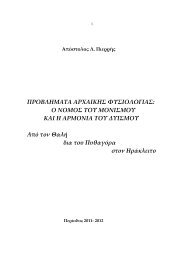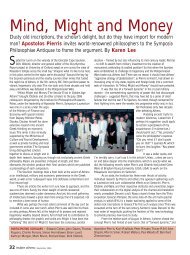APPENDIX C΄ ON DEPILATION: BODY COSMETICS IN CLASSICAL ...
APPENDIX C΄ ON DEPILATION: BODY COSMETICS IN CLASSICAL ...
APPENDIX C΄ ON DEPILATION: BODY COSMETICS IN CLASSICAL ...
You also want an ePaper? Increase the reach of your titles
YUMPU automatically turns print PDFs into web optimized ePapers that Google loves.
558 <strong>APPENDIX</strong> <strong>C΄</strong><br />
This semantic field of Ï¢ÎfiÓ thus, seems to have been in<br />
preclassical times like this, in our terms: shining bright brilliant<br />
resplendent shiny translucent transparent clear light (coloured) white.<br />
There existed also, of course, a perfectly matching sphere of connected<br />
meanings for ̤ϷÓ.<br />
We see that this field of signification, in all its unmentionable<br />
variety, can be easily arranged around three points of reference, so to<br />
speak, in three clusters: (1) bright, glistering, lustrous (2) clear,<br />
transparent (3) light (and as a particularly obvious case of lightcolouredness,<br />
white). This natural arrangement we also see taking<br />
place in the subtle colour distinctions and relationships in the colourtheories<br />
of the classical times: cf. especially Plato’s views in Timaeus<br />
67c sqq., where the ‰È·Ê·Ó¤˜, the Ï¢ÎfiÓ and the Ï·ÌappleÚeÓ Î·d ÛÙ›Ï-<br />
‚ÔÓ (answering to 2-3-1 respectively) are neatly distinguished, the two<br />
latter being brought in intimate connection (together with the âÚ˘ıÚfiÓ).<br />
One should also study carefully the intricate and very<br />
important Aristotelian tract appleÂÚd ¯ÚˆÌ¿ÙˆÓ. But in order to<br />
comprehend correctly the ancient understanding of colours, just as in<br />
all other similar endeavours to know the ancient way of seeing things,<br />
we must not strive to produce simple one-to-one correspondences<br />
between the ancient and our own schemes: for all too often the<br />
divisions are drawn along significantly different lines so that both the<br />
elements of a certain field and their structural arrangements can be<br />
markedly unfamiliar to us when we try to penetrate into ancient ways<br />
of feeling and into their own natural conceptual articulation.<br />
But let us return to our immediate topic, the Ï¢ÎfiÙ˘ as a quality<br />
of the skin of the male body. We must bear in mind the abovedelineated<br />
semantic analysis. The expression was proverbial: Ï¢ÎáÓ<br />
àÓ‰ÚáÓ Ôé‰bÓ ùÊÂÏÔ˜, depreciatory of white-skinned men. V.<br />
Macarius V, 55; Apostolius XIII, 35 adds the explanation âappled ÙáÓ<br />
àappleÚ¿ÎÙˆÓ, those who do not do anything, any job, and therefore by<br />
not being exposed to the sun and the wind keep their skin Ï¢ÎfiÓ; in<br />
Appendix Paroemigraphorum IV, 35 the proverb runs thus: Ôé‰bÓ<br />
àÓ‰ÚáÓ Ï¢ÎáÓ ùÊÂÏÔ˜ j Û΢ÙÔÙÔÌÂÖÓ and the same appears in Suda<br />
s. vv. and in Sch. ad Aristophanes, Pax 1310 with the variant Âå Ìc<br />
Û΢ÙÔÙÔÌÂÖÓ; Eustathius, p. 455.39, read the proverb in Aelius<br />
Dionysius’ collection without any addition, which is to be connected,<br />
as Kusterus saw in his note ad Suda loc.cit., to Aristophanes, Ecclesiaz.<br />
383 sqq,:










